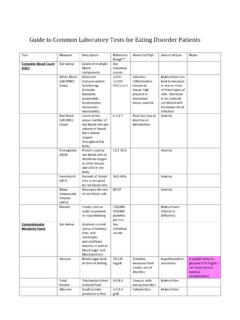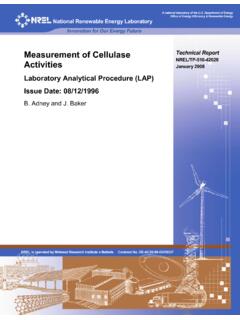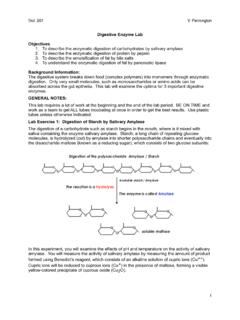Transcription of Lee 1 Jessica Lee AP Biology 23 October 2013 - Region 18
1 Lee 1 jessica lee ap biology Mrs. Kingston 23 October 2013 Abstract: The purpose of this lab is to investigate the impact of temperature, substrate concentration, enzyme concentration, and the presence of an inhibitor on the effectiveness and rate of an enzyme. If the concentration of the enzyme or substrate is increased, the rate of the reaction will be increased as well. If the temperature of the enzymes surrounding environment is increased, then the rate of the reaction will also be increased. If the substrate concentration is increased then the rate of the reaction will increase. If an inhibitor is added then the rate of the reaction will be decreased significantly. The dependent variable is the rate of the reaction. The independent variable is the concentration of enzyme, the concentration of the substrate, the temperature, and the addition of an inhibitor.
2 Introduction: enzymes are proteins that carry out chemical reactions. They are catalysts within living organisms and regulate the rate at which a chemical reaction is carried out (Koshland). enzymes range in their functions throughout living organisms; however metabolic enzymes are found in all cells of the body (Boncompagni). enzymes are essential to the breakdown of lipids, carbohydrates, proteins and other molecules in the cell (Koshland). There are three types of enzymes that effect the location and function of the enzyme. These three enzymes are metabolic enzymes , digestive enzymes , and food enzymes found in uncooked nuts, vegetables, and fruits (Boncompagni). enzymes specifically act as a catalyst, which is a chemical agent that is used to speed up the reaction without being used up Lee 2 (Campbell and Recce, page 152).
3 There are hundreds of different enzymes and the function of an enzyme is based upon the amino acids that make up the protein. Thus enzymes present in all cells play a major role in metabolism because without these enzymes reaction would take far too long to be carried out. enzymes have this ability to speed up reactions by lowering the activation energy, the energy needed to break the bonds of the reactants (Campbell and Reece, page 152). For each reaction the reactants must absorb energy from the surrounding to be able to break bonds. Bonds are recreated as energy is given off to the environment. When the molecules reach the peak of the activation energy, they are very unstable and in the transition state. When taking in energy, this normally means that the reaction is doing so by taking in heat energy and giving off heat energy as bonds are formed again.
4 This means that as bonds are being broken the reaction is endothermic, meaning that it is taking in heat energy from the surroundings, and exothermic as the bonds form, meaning that it is giving heat energy off to the surroundings (Campbell and Reece, page 152). Exergonic is synonymous to the term exothermic in this situation. However, in many situations there is not enough energy in the cell to overcome this energy barrier, and if the temperature was to be increased either the proteins would be denatured, or all the reactions would take place in the cell. enzymes can thus speed up these reactions and allow for them to take place (Campbell and Reece, page 153). enzymes are also very specific to the chemical process and will only match with certain reactions.
5 These reactions will take place in the active site of the enzyme. The substrate, the reactants of the reaction, bind to the active site, the only place on the enzyme a substrate can bind, creating an enzyme-substrate complex. The reactants are then converted to the products like in a normal reaction, but with the enzyme, the activation energy is much lower and the rate of the reaction is much faster. The shape of the enzymes , and active site, are a result of the amino acid sequence. As the substrate enters the active site the chemical groups and the R groups of the enzyme interact and the enzyme changes shape slightly to fit around the substrate even tighter. This is called induced fit Lee 3 (Campbell and Reece, page 154). The bonds that are formed at this point are relatively weak, normally hydrogen or ionic bonds.
6 enzymes have many ways in which they can lower activation energy, the first being activating a template. The template allows the substrates to come together in the proper orientation so that a reaction can take place (Campbell and Reece, page 154). At this point the enzyme can stretch and bend the substrate to make it reach its transition state and break the necessary binds for a reaction. By distorting the substrate less energy is needed to break these bonds, thus a lower activation energy. The enzyme may also give the substrate a better environment for the specific reaction to be carried out in that may not be present in the cell. For example, and enzyme might provide an acidic environment over a neutral environment of a cell. Finally, the enzyme might be essential to the reaction to take place.
7 In some cases covalent bonds might occur between the R group and the substrate for instances, but later the substrate will restore what was taken from the R group. Because enzymes are not affected or changed by the substrate, enzymes can be used over and over again. The role of the enzyme is to increase the rate of the reaction, and through these processed it does however; other factors can also have an effect on how fast the enzyme carries out this job. For example, the more substrate molecules that are present, the more frequently the substrate and enzyme will come in contact. At a certain point the concentration of the substrate will fill all the active cites and by adding more substrate the reaction is carried out unaffected (Campbell and Reece, page154).
8 At this point the only way to increase the rate of the reaction (when the substrate is saturated) is to add more enzymes that the excess substrate can fill. Temperature and pH also play a similar role in effecting the enzyme activity. As the temperature is increased the rate of a reaction is increased to a certain point. This occurs because as temperature is added there is more energy allowing the substrate to collide with the enzyme. Once the temperature becomes too high the enzymes are denatured because the hydrogen bonds and ionic bonds are disrupted. Most enzymes have an optimal temperature, and in human cells this is between Lee 4 35-40 C. Cells also have optimal pH values from about 6-8. Some enzymes , like those in your stomach, function best at a much lower pH (Campbell and Reece, page 155).
9 Along with these factors, there are nonproteins that help the enzyme carry out this catalysis. These adjuncts are called cofactors. When these cofactors are organic molecules they are referred to as coenzymes and vitamins are a great example of this. While these factors most likely will enhance the performance of the enzyme there are also enzyme inhibitors that inhibit the function of the enzymes . There are two types of inhibitors, competitive inhibitors and noncompetitive inhibitors. Competitive inhibitors will attach to the enzyme in the active site, which blocks the substrate from attaching to the enzyme. Noncompetitive inhibitors do not bind to the active site of the enzyme, but rather bind to another site of the enzyme, thus changing the shape of the enzyme and making the active site less effective in carrying out the reaction (Campbell and Reece, page 156).
10 These inhibitors are either reversible or irreversible. If the enzyme bonds to the enzyme through covalent bonds, it is usually irreversible. The use of inhibitors can also be done intentionally by the cell to regulate enzyme activity. When molecules bond to the enzyme and change the shape of the active site this is normally allosteric regulation. This can result in either inhibition or stimulation of an enzyme. This is seen through allosteric regulation. These enzymes are normally made of two or more subunits with their own active sites. There are both active and inactive forms of allosteric enzymes . If the inhibitor binds to an activator the shape is stabilized. If the inhibitor joins to an inhibitor, it stabilizes the inactive form as well (Campbell and Reece, page 157).






